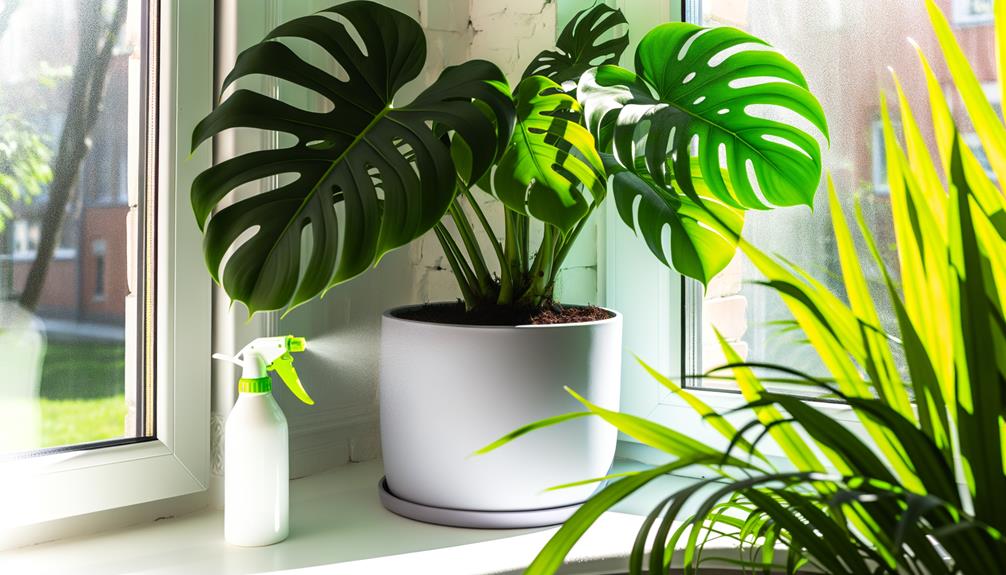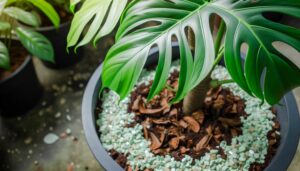Caring for an Monstera Standleyana: A Complete Guide!
Caring for a Monstera Standleyana requires precise management of light, water, and environmental conditions. Place it in bright, indirect light to avoid leaf scorch.
Water when the top inch of soil feels dry, using a mix containing perlite and orchid bark for excellent drainage. Maintain temperatures between 65°F and 80°F and keep humidity levels between 60% and 80%.
Regularly inspect for pests and signs of stress like yellowing leaves. Prune strategically to promote growth and health.
For repotting, choose slightly larger pots and trim any damaged roots to prevent rot. Mastering these steps ensures prime plant health.

Key Takeaways
- Provide bright, indirect light to avoid leaf scorch and promote healthy growth.
- Water consistently, allowing soil to dry out slightly between waterings to prevent root rot.
- Maintain temperature between 65°F and 80°F and humidity levels between 60% and 80%.
- Use well-draining soil mix with perlite and orchid bark for optimal aeration.
- Regularly inspect for pests and prune leggy stems to encourage fuller growth.
Understanding Monstera Standleyana
Understanding Monstera standleyana requires an in-depth analysis of its taxonomy, morphological traits, and native habitat. This tropical species belongs to the Araceae family and is characterized by its glossy, lanceolate leaves with white or yellow variegation.
You’ll notice the leaves are pinnately divided, an adaptation that aids in maximizing light capture. The plant’s aerial roots facilitate climbing and nutrient absorption from surrounding debris.
Native to Central and South America, Monstera standleyana thrives in humid, forested environments with well-draining soil rich in organic matter. Its epiphytic growth habit allows it to attach to trees, drawing moisture and nutrients from the air and rain.
Understanding these aspects is essential for replicating its natural conditions in cultivation.
Ideal Lighting Conditions
Providing perfect lighting conditions for Monstera standleyana involves ensuring it receives bright, indirect light to mimic its native understory habitat. Direct sunlight can scorch its leaves, while low light levels can stunt its growth. Situate your plant near an east-facing window or use sheer curtains to diffuse intense sunlight from south or west-facing windows.
| Lighting Type | Effect on Plant |
|---|---|
| Bright, Indirect | Excellent growth and health |
| Direct Sunlight | Leaf scorch, potential damage |
| Low Light | Stunted growth, poor health |
Monitor the leaf color and growth rate as indicators of proper lighting. Pale or yellow leaves can signify too much light, whereas elongated stems indicate insufficient light. Adjust your plant’s placement accordingly to maintain its vibrant health.
Watering Routine
To maintain peak health for your Monstera Standleyana, establish a watering routine that aligns with the plant’s natural needs. Typically, watering every 1-2 weeks suffices, but it’s essential to monitor soil moisture levels to prevent overwatering.
Watch for signs such as yellowing leaves and root rot, which indicate excessive water.
Optimal Watering Frequency
Determining the most suitable watering frequency for your Monstera Standleyana involves closely monitoring soil moisture levels and adjusting based on seasonal changes and indoor climate conditions. Utilize a moisture meter or the finger test to gauge soil dampness, ensuring the top two inches are dry before re-watering.
During the growing season (spring and summer), you may need to water more frequently due to increased transpiration and metabolic activity. Conversely, reduce watering in the dormant season (fall and winter) when the plant’s physiological processes slow down. Factors like indoor humidity, temperature fluctuations, and pot size also influence watering needs.
Consistency in observation and adjustment will maintain ideal hydration, promoting healthy growth and preventing root desiccation.
Signs of Overwatering
Overwatering your Monstera Standleyana often manifests through symptoms like yellowing leaves, mushy stems, and a noticeable musty aroma emanating from the soil. Yellow leaves indicate chlorosis due to root oxygen deprivation, while mushy stems result from cellular breakdown caused by excess water. A musty scent suggests fungal growth, a common consequence of persistently damp conditions.
To confirm overwatering, check the soil’s moisture level with a hygrometer; consistent readings above ideal moisture levels indicate overwatering. Guarantee proper drainage by using well-aerated soil and pots with drainage holes. Adjust your watering routine to allow the top inch of soil to dry out before re-watering. This will promote root health and prevent the onset of root rot.
Best Soil Mix
For best growth, you need a soil mix that guarantees excellent drainage and aeration, preventing root rot. Incorporate materials like perlite and orchid bark to enhance these properties.
Additionally, enrich the soil with organic matter such as compost or worm castings to provide essential nutrients.
Drainage and Aeration
To guarantee ideal drainage and aeration for your Monstera Standleyana, use a soil mix that combines equal parts of orchid bark, perlite, and peat moss. This blend ensures optimal oxygenation and prevents waterlogging, which is essential for root health.
The components provide:
- Orchid Bark: Enhances airflow and mimics the plant’s natural epiphytic environment.
- Perlite: Increases soil porosity, promoting faster drainage.
- Peat Moss: Retains moisture without becoming compacted, maintaining a balanced humidity level.
- Additional Organic Matter: Optional but can further enhance the mix’s texture and nutrient profile.
Nutrient-Rich Ingredients
In addition to promoting proper drainage and aeration, integrating nutrient-rich components into the soil mix is crucial for the healthy growth of your Monstera Standleyana. Start with a base of high-quality potting soil, which provides a balanced structure.
Integrate perlite or pumice to enhance aeration and prevent compaction. Add organic matter like compost or well-rotted manure to supply essential macronutrients (nitrogen, phosphorus, potassium). Include sphagnum peat moss to improve moisture retention and slightly acidify the soil, catering to Monstera’s preference for a pH range of 5.5 to 7.0.
Temperature and Humidity
Maintaining a perfect temperature range between 65°F and 80°F is crucial for the healthy growth of Monstera Standleyana. This tropical plant thrives in warm, stable conditions. Rapid temperature fluctuations can stress the plant, leading to stunted growth or leaf damage.
Humidity levels should be kept between 60% and 80% to mimic its native environment.
To achieve prime conditions:
- Use a hygrometer: Monitor humidity levels accurately.
- Employ a humidifier: Increase ambient moisture during dry periods.
- Mist regularly: Light misting can help maintain humidity.
- Avoid cold drafts: Keep the plant away from air conditioners and open windows.
Following these guidelines guarantees that your Monstera Standleyana remains strong and robust, fostering vigorous growth and vibrant foliage.
Fertilization Tips
Once you’ve got the temperature and humidity dialed in, providing the right nutrients is key to guaranteeing your Monstera Standleyana thrives. Use a balanced, water-soluble fertilizer with an N-P-K ratio of 20-20-20. Apply it every four weeks during the growing season, from spring to early autumn. Dilute the fertilizer to half strength to avoid nutrient burn.
Monitor for signs of over-fertilization, such as yellowing leaves or salt buildup on the soil surface. During the dormant winter months, reduce fertilization frequency to every six to eight weeks. Make sure the soil is moist before applying fertilizer to enhance absorption. Consistent, appropriate fertilization supports robust leaf development and overall plant well-being.
Pruning and Maintenance
When pruning your Monstera Standleyana, focus on removing dead leaves to prevent disease and foster healthy growth. Use sterilized tools to avoid pathogen transmission and encourage new growth by trimming just above a node.
Regular maintenance, including cleaning your plant tools after each use, promotes plant health and vigor.
Removing Dead Leaves
To maximize growth and health of your Monstera Standleyana, promptly remove dead leaves using sterilized pruning shears. This process prevents disease propagation and frees up resources for healthy foliage. Make sure you cut close to the main stem to avoid leaving stubs, which can become infection sites.
Key steps include:
- Sterilization: Disinfect pruning shears with rubbing alcohol before and after use.
- Inspection: Regularly check for yellowing or brown, crispy leaves.
- Cutting Technique: Angle your cuts to promote water runoff, reducing rot risk.
- Disposal: Properly dispose of dead leaves to prevent fungal spread.
Encouraging New Growth
Pruning your Monstera Standleyana strategically encourages robust new growth by redirecting the plant’s energy to emerging nodes and healthy leaves. Begin by identifying leggy stems and any sections exhibiting slower growth.
Use sterilized, sharp pruning shears to make precise cuts just above a node, ensuring you don’t damage the remaining tissue. This method, known as selective pruning, enhances hormonal balance and stimulates axillary bud development.
Regularly removing damaged or diseased foliage prevents resource wastage, allowing the plant to allocate more energy to vigorous parts. Additionally, consider pruning during the growing season, typically spring through early summer, when the plant’s metabolic activity is high.
This timing optimizes photosynthetic efficiency, further contributing to accelerated and healthy new growth.
Cleaning Plant Tools
Maintaining your pruning tools are meticulously cleaned and sterilized before and after use is crucial for preserving plant health and preventing the spread of pathogens. Employing sterilized tools minimizes the risk of transferring bacteria or fungi to your Monstera Standleyana, which can lead to infections.
To achieve peak sanitation, follow these steps:
- Disinfectants: Use a solution like 70% isopropyl alcohol or a 10% bleach solution.
- Rinse: Thoroughly rinse tools with water to remove any chemical residues.
- Drying: Allow tools to air dry or use a clean cloth to prevent rust.
- Sharpening: Maintain sharp edges to guarantee clean cuts, reducing plant stress and promoting healing.
Repotting Guide
When repotting Monstera Standleyana, make certain the new container is just one size larger to prevent excess soil moisture and root rot. Select a well-draining potting mix, ideally a blend of peat, perlite, and orchid bark. This mix guarantees optimal aeration and moisture retention.
Gently remove the plant from its current pot, taking care not to damage the roots. Inspect the root system; trim any dead or decayed roots using sterilized scissors. Place the plant in the new pot, filling around it with the prepared mix. Water thoroughly until you see drainage from the bottom.
Ensure the plant is positioned in a bright, indirect light spot. Monitor for signs of stress, adjusting care as needed to facilitate acclimatization.
Pests and Diseases
Monstera Standleyana is susceptible to a variety of pests and diseases, including spider mites, scale insects, and root rot, requiring attentive monitoring and prompt intervention. To effectively manage these issues, you should:
- Spider mites: Inspect undersides of leaves for fine webbing and stippling damage. Use miticides or insecticidal soap for control.
- Scale insects: Observe stems and leaves for small, immobile bumps. Treat with horticultural oil or systemic insecticides.
- Root rot: Ensure proper soil drainage and avoid overwatering. If roots are mushy and black, trim affected areas and repot.
- Fungal infections: Look for spots or lesions on leaves. Apply fungicides and improve air circulation to mitigate spread.
Regularly checking your plant can prevent these issues from escalating.
Propagation Techniques
Propagating Monstera Standleyana involves taking stem cuttings and rooting them in water or a well-draining soil mix to encourage new growth. First, select a healthy stem with at least one node and a couple of leaves. Cut below the node using sterilized shears. You can then place the cutting in water or a potting mix composed of perlite and peat moss.
| Step | Action | Details |
|---|---|---|
| 1 | Select Stem | Choose a healthy stem with a node |
| 2 | Cut Stem | Use sterilized shears to cut below the node |
| 3 | Rooting | Place in water or a soil mix |
| 4 | Monitor | Check for root growth weekly |
| 5 | Transplant | Move to a larger pot once roots are 2 inches long |
Maintain humidity and indirect light for best results.
Conclusion
To sum up, caring for a Monstera standleyana isn’t just a task; it’s a thrilling botanical adventure!
With perfect lighting, meticulous watering, the ideal soil mix, and precise temperature and humidity control, you’ll transform your plant into a verdant marvel.
Prune and repot like a pro, and you’ll fend off pests and diseases with ease.
Master propagation techniques, and you’ll become the ultimate Monstera whisperer, cultivating a plant that’s the envy of every plant enthusiast!






